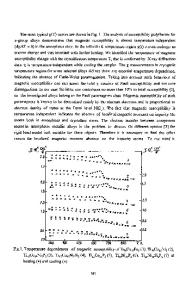Influence of casting temperature on the thermal stability of Cu- and Zr-based metallic glasses: Theoretical analysis and
- PDF / 370,323 Bytes
- 6 Pages / 612 x 792 pts (letter) Page_size
- 17 Downloads / 945 Views
H.F. Zhanga) Shenyang National Laboratory for Materials Science, Institute of Metal Research, Chinese Academy of Sciences, Shenyang 110016, People’s Republic of China
H. Wang Faculty of Engineering and Surveying, The University of Southern Queensland, Toowoomba, Queensland 4350, Australia
B.Z. Ding and Z.Q. Hu Shenyang National Laboratory for Materials Science, Institute of Metal Research, Chinese Academy of Sciences, Shenyang 110016, People’s Republic of China (Received 16 April 2008; accepted 24 June 2008)
Influence of casting temperature on the thermal stability of Cu- and Zr-based metallic glasses (MGs) was analyzed based on the monomer-cluster structural model using the Johnson–Mehl–Avrami (JMA) equation. The result indicates that increasing the casting temperature can enhance the thermal stability of MGs. It is suggested that it be attributed to the decrease in the amount of the local ordering clusters induced by the elevating casting temperature. The prediction is confirmed by continuous heating transformation diagrams constructed for the Cu- and Zr-amorphous samples obtained under different casting temperatures.
I. INTRODUCTION
Metallic glass (MG) is thermodynamically metastable at room temperature and will undergo phase transformation upon heating, i.e., devitrification, which needs atomic rearrangement and leads to the formation of crystalline and quasicrystalline phases.1–4 Such a structural evolution upon heating, i.e., thermal stability, will affect the properties of the materials negatively or positively.5–12 It has been reported in Mg-, Fe-, Co-, and Ni-based amorphous alloys that structural relaxation during annealing results in brittleness.5–7 However, in some other cases, the glassy matrix composites reinforced by the in situ formation of nanocrystalline particles were prepared through annealing, leading to apparently improving the mechanical and magnetic properties of the materials.8–12 In particular, for Cu- and Zr-based amorphous alloys, the introduction of the nanocrystals makes them exhibit high strength and good compressive ductility.8,9,13–18 Obvi-
a)
Address all correspondence to this author. e-mail: [email protected] DOI: 10.1557/JMR.2008.0335 2714
http://journals.cambridge.org
J. Mater. Res., Vol. 23, No. 10, Oct 2008 Downloaded: 03 Apr 2015
ously, the thermal stability is a key property to understand the structural transformation during either the solidification or annealing process. As a result, one can say that the thermal property is one of the most important properties of MGs. The enhancement of the thermal stability will certainly broaden their applications. Some characteristic thermal parameters, i.e., onset crystallization temperature and supercooled liquid region, are usually used to evaluate the thermal stability of MGs.2 Because of kinetic features of the glass transition and crystallization,3,4,19 those parameters are closely related to the heating rate. Therefore, they could not be used alone to evaluate the thermal properties of MGs. Time-temperature-transformation
Data Loading...











